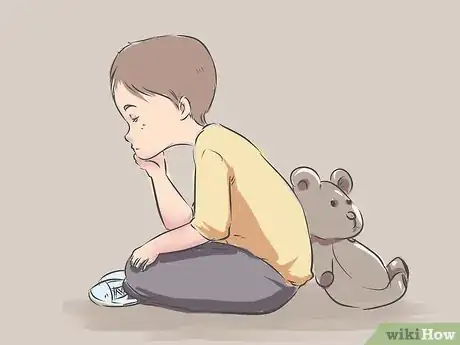This article was co-authored by Tasha Rube, LMSW. Tasha Rube is a Licensed Social Worker based in Kansas City, Kansas. Tasha is affiliated with the Dwight D. Eisenhower VA Medical Center in Leavenworth, Kansas. She received her Masters of Social Work (MSW) from the University of Missouri in 2014.
There are 21 references cited in this article, which can be found at the bottom of the page.
wikiHow marks an article as reader-approved once it receives enough positive feedback. In this case, 91% of readers who voted found the article helpful, earning it our reader-approved status.
This article has been viewed 85,372 times.
Most autistic children are not aggressive, but many will melt down and throw enormous "tantrums" when they are exposed to difficult situations or don't get what they want. Autistic children do not respond in this way to be difficult, but because they don't know how else to respond. By using some simple strategies, you can help to reduce your child's meltdowns and tantrums, and even improve self-control in an autistic child.
Steps
Handling Meltdowns
-
1Consider the cause of your child’s meltdown. A meltdown is when an autistic person can no longer handle the bottled-up stress that they have been holding back, and it is released in an outburst that looks like a tantrum. Your child’s meltdown was most likely caused by something that is frustrating him. Autistic children don't melt down because they want to be difficult, but because of something stressful. They may be trying to say that they cannot cope with a situation, stimulus, or routine change. They may melt down out of frustration or as a last resort if other communication attempts fail.[1]
- Meltdowns can take many forms. They may involve screaming, crying, covering ears, self-injurious behavior, or occasionally aggression.
-
2Find ways to make home life more comfortable for your child. Since meltdowns come from pent-up stress, creating a friendlier environment can minimize stressors in the child's life.
- Follow a routine to give your child a sense of stability. Creating a picture schedule can help them visualize the routine.[2]
- If changes have to occur, it is best to prepare your child for these changes by showing them the changes that are to be made through pictures or social stories. Explain why the change will occur. This will help your child understand what to expect and be calm when it happens.
- Allow your child to leave stressful situations as needed.
Advertisement -
3Teach stress management techniques to your child. Some autistic children do not understand how to deal with their emotions and may need extra guidance. Congratulate your child when they successfully demonstrate stress management techniques.[3]
- Come up with plans for specific stressors (loud noises, crowded rooms, etc.).
- Teach self-calming techniques: deep breathing, counting, taking breaks, etc.
- Have a plan for how a child can tell you if something is bothering them.
-
4Notice when the child is stressed, and validate their feelings. Treating their needs as natural and important will help them learn that it's okay to express them.[4]
- "I see your face is all scrunched up. Is the loud thumping bothering you? I can ask your sisters to go play outside."
- "You seem angry today. Would you like to tell me why you're upset?"
-
5Model positive behavior for your child. Your child observes you when you're stressed, and learns to mimic your coping behaviors. Keeping your cool, clearly expressing your feelings, and taking quiet time when you need it will help your child learn to do the same.
- Consider narrating your choices. "I'm feeling upset right now, so I'm going to take a quick break and take some deep breaths. Then I'll be right back."
- After you use a behavior several times, the child is likely to try it out for themselves.
-
6Create a quiet space for your child. It is important to recognize your child may have difficulties processing and regulating multiple sights, sounds, smells and textures. Too much stimulation and your child can become stressed, overwhelmed, and prone to meltdowns. In this circumstance, a quiet room can help the child calm down.[5]
- Teach the child to signal that they need the room. They can point to the room, show a picture card representing the room, use sign language, type, or ask verbally.
- Read How to Make a Calming Down Corner for additional tips.
-
7Keep a meltdown log. Keeping a record of each time that your child has a meltdown can also help you to understand the reasons for the behavior. Try answering the following questions in writing the next time your child has a meltdown:[6]
- What made the child upset? (Consider that the child may have been holding back stress for hours.)
- What signs of stress did the child exhibit?
- If you noticed any stress buildup, what did you do? Was it effective?
- How could you prevent a similar meltdown in the future?
-
8Talk to your child about hitting and bad behavior. Remember that autism is not an excuse for hitting or being mean. If the child is mean to others, talk to him once they have calmed down. Explain that the particular action was not acceptable, and tell them what they can do instead.[7]
- "It was not okay for you to hit your brother. I understand that you were upset, but hitting hurts people, and it's not okay to hurt people when you're angry. If you're mad, you can take some deep breaths, take a break, or tell me about the problem."
-
9Contact one of the child’s other caregivers for assistance during a meltdown. Autistic people have been traumatized or killed in the hands of the police.[8] If you cannot handle a meltdown, get one of the child's other caregivers to help you.
- Only call the police in extreme, physically harmful situations. Police may respond violently to your child, which could cause symptoms of PTSD and lead to worse meltdowns.[9]
Handling Tantrums
-
1Consider how your actions can affect your child's tantrums. Children throw tantrums when they want something and do not get it. By acting out, the child may hope to get what they want in the end. If you give the child what they want (e.g. ice cream, or a delayed bathtime/bedtime), then the child will learn that tantrums are a good way to get things.[10]
-
2Address tantrum behavior early. It is much easier to start addressing tantrums when the autistic person is a child. For example, a 6-year-old boy who throws himself on the floor is much easier to manage compared to a 16-year-old. Also, the child will be less likely to cause injury to themself or others.[11]
-
3Ignore tantrum behavior. Planned ignoring can work best for yelling, swearing, and sulking. This will teach the child that the behavior is not an effective way to get attention. It helps to clearly communicate this idea, such as "I can't understand what's wrong if you're pouting back there. But if you would like to calm down a little and explain what is wrong, I would be happy to listen to you."[12]
-
4Intervene if the child is being mean or doing dangerous things. Always step in if the child begins throwing things, taking things that belong to others, or hitting. Ask the child to stop and then explain why the behavior is not okay.
-
5Invite your child to behave better. Tell your child that they can choose to act in a way that will get the desired response. Explaining this to your child will help your child understand the best way to get what they want (or at least a listening ear or a compromise).[13]
- For example, you can tell your child, "If you'd like me to help you, you can take a few deep breaths and tell me what's wrong. I'm here for you if you need me."
Using the ABCs of Tantrums
-
1Stay “Ahead” of the problem. Keep a record (preferably in a writing journal) of when the meltdown regularly occurs e.g. before an outing, before a bath, at bedtime, etc. Write down the A-B-C (antecedents, behaviors, consequences) of the problem. Doing this will allow you to figure out your child’s behavior and what it is that you can do to help prevent and address problems as they occur.[14]
- Antecedents: What were the factors leading up to the meltdown (time, date, place, and incident)? How did these factors influence the problem? Were you doing anything that was painful or upsetting to the child?
- Behaviors: What were the specific behaviors exhibited by the child?
- Consequences: What were the consequences of the child’s actions for the mentioned behaviors? What did you do as a result? What happened to the child?
-
2Use the A-B-C journal to identify "triggers" for your child. Then use this knowledge to teach your child the “if – then”. For example, if the child is upset that another person has broken his toy, then it is a good time to ask for help.[15]
-
3Discuss your ABC journal with a therapist. After you have collected your ABC information, it is a good idea to share this information with a therapist to provide a good picture of your child’s behavior in specific scenarios.
Helping Your Child Communicate
-
1Help your child express basic needs. If they can communicate the thing that is bothering them, they are less likely to build up stress or resort to bad behavior.[16] Your child needs to know how to say or communicate the following:
- "I'm hungry."
- "I'm tired."
- "I need a break, please."
- "That hurts."
-
2Teach your child to try to identify their own emotions. Many autistic children have trouble understanding their feelings, and it may be helpful for them to point to pictures or learn the physical symptoms that accompany feelings. Explain that telling people how they feel (such as "The grocery store makes me scared") allows people to help fix problems (such as "You can wait outside with your big sister while I finish shopping").
- Make it clear that if they communicate, you will listen to them. This eliminates the need for a tantrum.
-
3Remain calm and consistent. The meltdown-prone child will need a calm, stable parental figure as well as consistency from all those involved with their care. You will not be able to address your child’s self-control until you have control of yourself first.[17]
-
4Assume that your child wants to behave well. This is called "presuming competence" and it greatly improves autistic people's social skills. Autistic people are much more likely to open up if they feel that they will be respected.
-
5Explore alternative communication. If an autistic child is not ready for speech, there are other ways to have him communicate with you. Try sign language, typing, picture exchange systems, or whatever a therapist recommends.[18]
Trying Other Strategies
-
1Know that your actions can affect your child’s meltdowns. For example, if you continue doing something that upsets your child (such as exposing them to painful sensory stimuli or pushing something they don't want), they may lash out. Children melt down more frequently if they believe that it's the only way to make parents acknowledge their feelings and desires.[19]
-
2Treat your child with respect. Coercing him, ignoring the fact that they are not comfortable with something, or physically restraining him is damaging. Respect your child's autonomy.
- Obviously, you cannot always honor a "no." If you are not going to do what they want, tell them why: "It's important that you sit in the car seat because it keeps you safe. If we get in an accident, the car seat will protect you."
- If something bothers him, find out why, and try to fix the problem. "Is the car seat uncomfortable? Would it help if you sat on a little pillow?"
-
3Consider medication. Medications such as selective serotonin reuptake inhibitors (SSRIs), antipsychotic medications, and mood stabilizers can be partially effective in helping children who are easily upset. However, like with any medication, there are side effects, so you must take the time to really decide if medication is the best option.[20]
- There is enough research data to show that a medication by name Risperidone is quite effective for the short-term treatment of aggressive and self-injurious behaviors in autistic children. Speak with a doctor or therapist about the pros and cons of this medication.
-
4Seek the help of a therapist. A therapist can help your child improve in their communication as well. Be sure to find one that works with autistic children. Your doctor or many of the good autism spectrum disorder support groups will be able to help find a recommended therapist.[21]
-
5Make steps easier for your child. For example, if your child does not like to get dressed, break up the complex process into basic "one-at-a-time" steps. This will help you understand where some of the difficulties are with your child undertaking a particular activity. As such, without even speaking, your child is communicating with you about a concern they have.[22]
-
6Use social stories, picture books, and playtime to teach good behavior. The library is full of children's books that teach skills, and you can teach skills through play time as well.
- For example, if one of your dolls is angry, you can have that doll step off to the side to take deep breaths. The child will learn that this is what people do when they are angry.
-
7Consider a reward system. Work with a specialist to implement a reward system so your child can be rewarded for remaining calm. Rewards can involve praise ("You did such a good job handling that crowded grocery store! That was very nice deep breathing"), gold stars on a calendar, or physical rewards. Help your child feel proud of their accomplishments.[23]
-
8Give your child plenty of love and attention. When your child has a strong bond with you, they will learn to come to you when they need help and listen to you.
Warnings
- Speak with a doctor or therapist before making any major changes to your child’s lifestyle.⧼thumbs_response⧽
References
- ↑ https://www.autism.org.uk/advice-and-guidance/topics/behaviour/meltdowns/all-audiences
- ↑ O'Leary, KD, and Wilson, GT, (1975), Behavior Therapy: Application and Outcome, ISBN 978-0130738752
- ↑ https://nocoassessmentcenter.com/stress-management-plans-for-kids-with-autism/
- ↑ https://opendoorstherapy.com/part-2-of-autism-expert-insights-tips-to-support-you-in-parenting-your-child-with-autism-during-covid-19/
- ↑ Barlow, DH, and Durand, VM, (2009), Abnormal Psychology: An integrative approach, ISBN 978-1285755618
- ↑ https://www.autism.org.uk/advice-and-guidance/topics/behaviour/meltdowns/all-audiences
- ↑ https://www.autism.org.uk/advice-and-guidance/topics/behaviour/distressed-behaviour/all-audiences
- ↑ https://www.spectrumnews.org/news/why-autism-training-for-police-isnt-enough/
- ↑ http://www.theguardian.com/uk/2013/feb/17/police-restraint-autistic-boy (content warning: brief ableism)
- ↑ https://www.tpathways.org/blog/autism-tantrum-behavioral-strategies/
- ↑ Antai-Otong, D, (2003), Psychiatric Nursing: Biological and Behavioural Concepts, ISBN 978-1418038724
- ↑ http://www.autism-help.org/behavior-tactical-ignoring-autism.htm
- ↑ https://childmind.org/guide/parents-guide-to-problem-behavior/#block_d78b1191-8133-46b5-b0ed-ff70c3643da0
- ↑ O'Leary, KD, and Wilson, GT, (1975), Behavior Therapy: Application and Outcome, ISBN 978-0130738752
- ↑ https://journals.sagepub.com/doi/abs/10.1177/109830070100300401
- ↑ O'Leary, KD, and Wilson, GT, (1975), Behavior Therapy: Application and Outcome, ISBN 978-0130738752
- ↑ http://www.ncbi.nlm.nih.gov/pubmed/18929056
- ↑ https://raisingchildren.net.au/autism/development/language-development/augmentative-communication-asd
- ↑ https://childmind.org/guide/parents-guide-to-problem-behavior/
- ↑ http://www.ncbi.nlm.nih.gov/pubmed/12463518
- ↑ http://www.everydayhealth.com/autism/managing-aggression-in-kids.aspx
- ↑ Buchannan, S.M. & Weiss, M.J. (2006). Applied Behaviour Analysis and Autism: An Introduction. Autism: NJ
- ↑ http://www.nejm.org/doi/full/10.1056/NEJMoa013171#t=articleTop

























































































Medical Disclaimer
The content of this article is not intended to be a substitute for professional medical advice, examination, diagnosis, or treatment. You should always contact your doctor or other qualified healthcare professional before starting, changing, or stopping any kind of health treatment.
Read More...